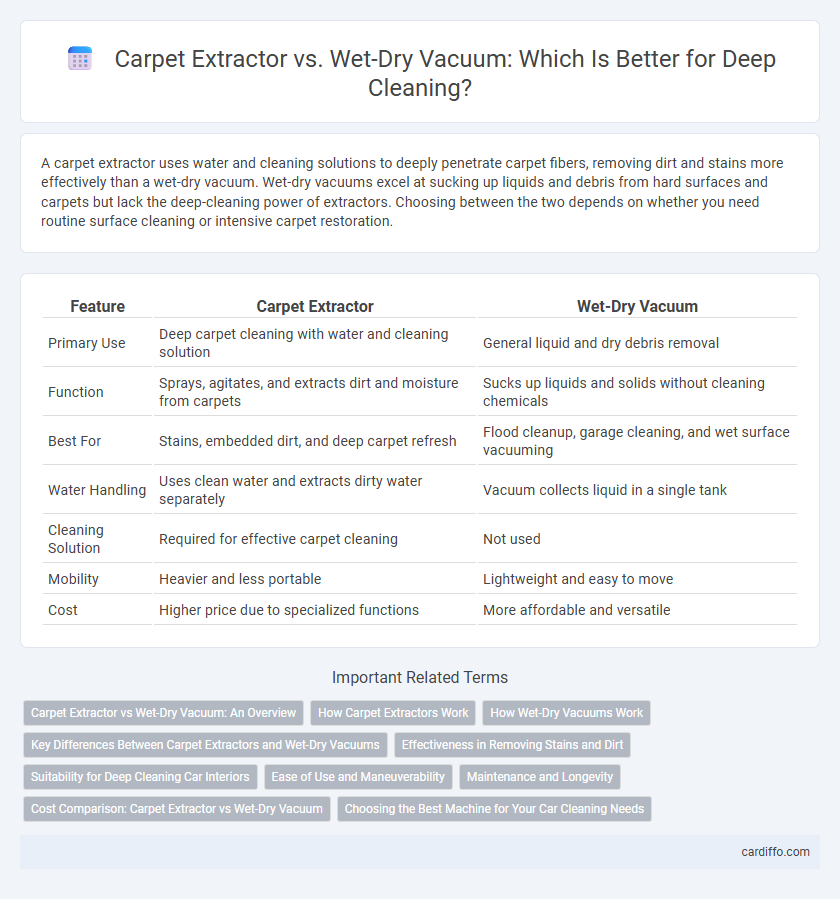A carpet extractor uses water and cleaning solutions to deeply penetrate carpet fibers, removing dirt and stains more effectively than a wet-dry vacuum. Wet-dry vacuums excel at sucking up liquids and debris from hard surfaces and carpets but lack the deep-cleaning power of extractors. Choosing between the two depends on whether you need routine surface cleaning or intensive carpet restoration.
Table of Comparison
| Feature | Carpet Extractor | Wet-Dry Vacuum |
|---|---|---|
| Primary Use | Deep carpet cleaning with water and cleaning solution | General liquid and dry debris removal |
| Function | Sprays, agitates, and extracts dirt and moisture from carpets | Sucks up liquids and solids without cleaning chemicals |
| Best For | Stains, embedded dirt, and deep carpet refresh | Flood cleanup, garage cleaning, and wet surface vacuuming |
| Water Handling | Uses clean water and extracts dirty water separately | Vacuum collects liquid in a single tank |
| Cleaning Solution | Required for effective carpet cleaning | Not used |
| Mobility | Heavier and less portable | Lightweight and easy to move |
| Cost | Higher price due to specialized functions | More affordable and versatile |
Carpet Extractor vs Wet-Dry Vacuum: An Overview
Carpet extractors use heated water and detergent to deep-clean embedded dirt from carpet fibers, restoring texture and removing stains effectively. Wet-dry vacuums primarily suction up liquid spills and surface debris, offering versatile cleanup but without the deep-cleaning power of extraction. For thorough carpet maintenance, carpet extractors provide superior soil removal, while wet-dry vacuums excel in handling a variety of wet or dry messes quickly.
How Carpet Extractors Work
Carpet extractors use powerful suction combined with hot water and cleaning solution to deeply penetrate carpet fibers, loosening dirt and debris for thorough removal. Unlike wet-dry vacuums that primarily suck up surface moisture and debris, extractors employ a rinse and extraction process that improves cleaning efficiency and restores carpet appearance. This method ensures carpets are left cleaner and drier, reducing the risk of mold and residue buildup.
How Wet-Dry Vacuums Work
Wet-dry vacuums operate by combining strong suction with powerful motors to remove both liquid spills and dry debris from carpets, hard floors, and upholstery. Equipped with separate tanks for clean and dirty water, these vacuums efficiently extract moisture and dirt simultaneously, preventing recontamination. Advanced filtration systems in wet-dry vacuums enhance air quality by capturing fine particles, making them ideal for deep cleaning and quick drying in various environments.
Key Differences Between Carpet Extractors and Wet-Dry Vacuums
Carpet extractors use a combination of hot water, cleaning solution, and powerful suction to deep clean carpets by removing dirt and stains embedded within the fibers. Wet-dry vacuums are versatile machines designed primarily for liquid and solid debris pickup, offering less specialized carpet cleaning capabilities. The main difference lies in carpet extractors delivering enhanced deep cleaning through agitation and extraction, while wet-dry vacuums excel at general debris removal and water extraction on multiple surfaces.
Effectiveness in Removing Stains and Dirt
Carpet extractors deliver deep cleaning by injecting hot water and detergent into carpet fibers, effectively breaking down and removing stubborn stains and embedded dirt. Wet-dry vacuums excel at surface-level cleanup by suctioning loose debris and liquids but lack the agitation and rinsing capabilities required for thorough stain removal. For intensive carpet stain treatment, carpet extractors provide superior effectiveness compared to wet-dry vacuums.
Suitability for Deep Cleaning Car Interiors
Carpet extractors provide superior deep cleaning for car interiors by using strong water pressure and powerful suction to remove embedded dirt, stains, and allergens from fabric surfaces. Wet-dry vacuums excel at general debris removal but lack the focused extraction capabilities needed to thoroughly clean carpet fibers and upholstery. For intensive cleaning of car interiors, carpet extractors offer a more effective solution than wet-dry vacuums.
Ease of Use and Maneuverability
Carpet extractors typically offer specialized tools and attachments designed for deep cleaning carpets with concentrated water spray and suction, but they tend to be bulkier and heavier, making them less maneuverable in tight spaces. Wet-dry vacuums provide greater ease of use with their lightweight design and versatile functionality, allowing users to quickly switch between liquid spills and dry debris while effortlessly navigating around furniture and corners. For those prioritizing agility and straightforward operation, wet-dry vacuums generally outperform carpet extractors in terms of maneuverability and user-friendliness.
Maintenance and Longevity
Carpet extractors require regular cleaning of brushes, hoses, and water tanks to prevent mold and maintain suction power, extending their operational life significantly. Wet-dry vacuums demand routine filter replacement and immediate debris removal to avoid clogging and motor damage, ensuring consistent performance over time. Proper maintenance protocols for both machines directly influence their durability and efficiency, making scheduled upkeep essential for long-term investment.
Cost Comparison: Carpet Extractor vs Wet-Dry Vacuum
Carpet extractors generally have a higher upfront cost, ranging from $300 to $1,500, due to their specialized cleaning technology and deeper cleaning capabilities. Wet-dry vacuums are more affordable, typically priced between $100 and $400, making them a budget-friendly option for basic wet and dry messes. Long-term maintenance costs for carpet extractors can be higher because of specialized parts and cleaning solutions, whereas wet-dry vacuums have lower maintenance expenses and simpler repairs.
Choosing the Best Machine for Your Car Cleaning Needs
Carpet extractors are designed for deep cleaning by injecting water and cleaning solution into carpet fibers, then extracting dirt and moisture, making them ideal for removing stubborn stains and embedded grime from car interiors. Wet-dry vacuums provide versatile cleaning by handling both liquid spills and dry debris, offering strong suction but lacking the deep-cleaning capability of carpet extractors. Choosing the best machine depends on the level of cleaning required: carpet extractors excel in thorough carpet and upholstery care, while wet-dry vacuums offer convenience for general debris removal and quick cleanups.
Carpet extractor vs Wet-dry vacuum Infographic

 cardiffo.com
cardiffo.com